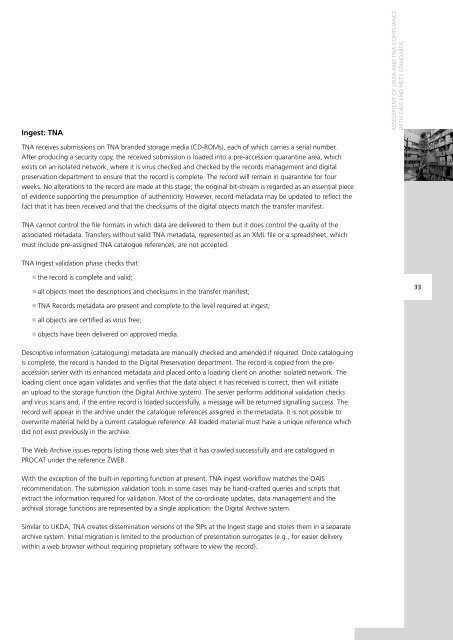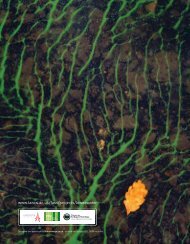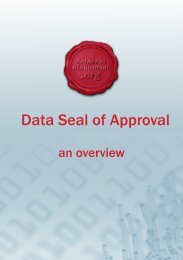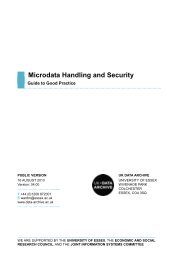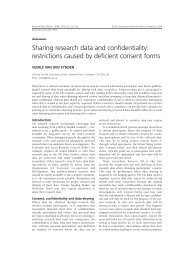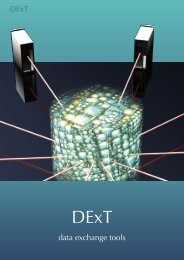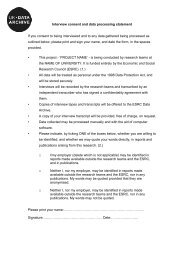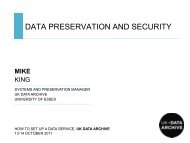OAIS/METS Report (PDF) - UK Data Archive
OAIS/METS Report (PDF) - UK Data Archive
OAIS/METS Report (PDF) - UK Data Archive
You also want an ePaper? Increase the reach of your titles
YUMPU automatically turns print PDFs into web optimized ePapers that Google loves.
Ingest: TNA<br />
ASSESSMENT OF <strong>UK</strong>DA AND TNA COMPLIANCE<br />
WITH <strong>OAIS</strong> AND <strong>METS</strong> STANDARDS<br />
TNA receives submissions on TNA branded storage media (CD-ROMs), each of which carries a serial number.<br />
After producing a security copy, the received submission is loaded into a pre-accession quarantine area, which<br />
exists on an isolated network, where it is virus checked and checked by the records management and digital<br />
preservation department to ensure that the record is complete. The record will remain in quarantine for four<br />
weeks. No alterations to the record are made at this stage; the original bit-stream is regarded as an essential piece<br />
of evidence supporting the presumption of authenticity. However, record metadata may be updated to reflect the<br />
fact that it has been received and that the checksums of the digital objects match the transfer manifest.<br />
TNA cannot control the file formats in which data are delivered to them but it does control the quality of the<br />
associated metadata. Transfers without valid TNA metadata, represented as an XML file or a spreadsheet, which<br />
must include pre-assigned TNA catalogue references, are not accepted.<br />
TNA Ingest validation phase checks that:<br />
■ the record is complete and valid;<br />
■ all objects meet the descriptions and checksums in the transfer manifest;<br />
33<br />
■ TNA Records metadata are present and complete to the level required at ingest;<br />
■ all objects are certified as virus free;<br />
■ objects have been delivered on approved media.<br />
Descriptive information (cataloguing) metadata are manually checked and amended if required. Once cataloguing<br />
is complete, the record is handed to the Digital Preservation department. The record is copied from the preaccession<br />
server with its enhanced metadata and placed onto a loading client on another isolated network. The<br />
loading client once again validates and verifies that the data object it has received is correct, then will initiate<br />
an upload to the storage function (the Digital <strong>Archive</strong> system). The server performs additional validation checks<br />
and virus scans and, if the entire record is loaded successfully, a message will be returned signalling success. The<br />
record will appear in the archive under the catalogue references assigned in the metadata. It is not possible to<br />
overwrite material held by a current catalogue reference. All loaded material must have a unique reference which<br />
did not exist previously in the archive.<br />
The Web <strong>Archive</strong> issues reports listing those web sites that it has crawled successfully and are catalogued in<br />
PROCAT under the reference ZWEB.<br />
With the exception of the built-in reporting function at present, TNA ingest workflow matches the <strong>OAIS</strong><br />
recommendation. The submission validation tools in some cases may be hand-crafted queries and scripts that<br />
extract the information required for validation. Most of the co-ordinate updates, data management and the<br />
archival storage functions are represented by a single application: the Digital <strong>Archive</strong> system.<br />
Similar to <strong>UK</strong>DA, TNA creates dissemination versions of the SIPs at the Ingest stage and stores them in a separate<br />
archive system. Initial migration is limited to the production of presentation surrogates (e.g., for easier delivery<br />
within a web browser without requiring proprietary software to view the record).


